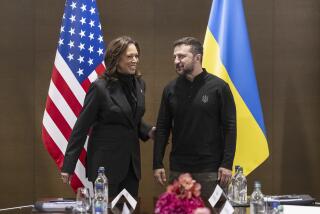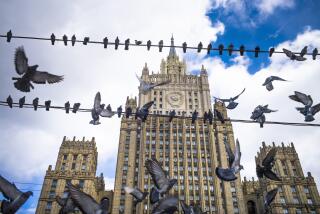U.S., Russia diplomats canât bridge Syria gaps
BEIRUT â The top U.S. and Russian diplomats failed to bridge critical differences about Syria during talks in Russia on Friday, leaving prospects uncertain for a high-level international âaction groupâ scheduled to gather Saturday in Geneva.
Secretary of State Hillary Rodham Clinton attempted to persuade Russian Foreign Minister Sergei Lavrov that world powers need to take a more assertive role in bringing about a âpolitical transitionâ to end the raging violence in Syria.
U.S. officials say that as part of any transition, Syrian President Bashar Assad must go. But Russia has insisted that other nations cannot force out Moscowâs longtime ally and that Syrians must decide, without external influence, who leads them.
Fridayâs encounter in St. Petersburg apparently did not alter fundamental differences about how to end the violence in Syria.
A senior administration official said the two diplomats had âserious discussions on all areas of difficultyâ on Syria, but that important gaps remained.
Nevertheless, U.S. officials have concluded that the Saturday meeting â meant to salvage United Nations special envoy Kofi Annanâs faltering peace plan and hammer out a transition blueprint for Syria â may still be productive, the official said.
The Russia foreign minister sounded an upbeat tone after meeting with Clinton, the Russian state RIA Novosti news agency reported.
âWe have a very good chance tomorrow in Geneva to find a common denominator and find a path forward in order to stimulate the implementation of Annanâs plan,â RIA Novosti quoted Lavrov as saying. âWeâre agreeing on most things.â
The Russian diplomat has said Syrian authorities are prepared to withdraw their forces from populated areas in conjunction with a similar pullback by rebel fighters. But Annan has said that the government has the âfirst responsibilityâ to redeploy forces.
Russiaâs support for any U.N.-backed transition plan for Syria is crucial because Moscow is a veto-wielding permanent member of the Security Council.
The Geneva meeting comes as a wave of escalating violence is sweeping across Syriaâs many contested zones, including the central city of Homs and the restive Damascus suburb of Duma, which has become a battleground. Opposition activists have alleged a massacre of civilians in Duma, while the government says dozens of âterroristsâ have been killed in an offensive.
The amended peace plan from Annan envisions a Syrian âtransitionalâ national unity government that could include members of the current government and opposition figures.
Although the plan does not explicitly address Assadâs fate, the transitional administration would bar anyone âwhose continued presence and participation would undermine the credibility of the transition and jeopardize stability and reconciliation.â U.S. officials argue that Assad squarely fits the definition of someone who should be disqualified.
The transition proposal is expected to be the focus of Annanâs much-awaited âaction groupâ meeting in Geneva.
The high-voltage guest list includes the foreign ministers of all five permanent U.N. Security Council members, including Clinton and Lavrov, along with ministers from Turkey, Iraq, Kuwait and Qatar. Iran, a close Assad ally, was not invited at Washingtonâs insistence. The session is widely viewed as a last chance to rescue Annanâs peace plan.
Assad is Russiaâs last major Arab ally, following the U.S.-supported toppling of two other Arab autocrats, Iraqâs Saddam Hussein andLibyaâs Moammar Kadafi.
Street demonstrations that began almost 16 months ago against Assad have evolved into a full-fledged insurgency featuring thousands of rebels across the country battling government troops and armor.
As the violence in Syria escalates, opposition-linked monitoring groups have regularly reported daily civilian death tolls exceeding 100 and have blamed government forces for various âmassacres.â The government has accused the opposition of exaggerating casualty counts for public relations purposes and concocting stories of massacres in a bid to sway global opinion in advance of major international meetings on Syria, such as the Saturday session in Geneva.
A recent U.N.-commissioned study found that killings in Syria were increasingly sectarian in nature and warned of âcatastrophicâ consequences should the spiraling violence continue unchecked.
Government tanks, artillery and attack helicopters have been laying siege to densely populated Damascus suburb of Duma, the opposition said. One account, which could not be independently verified, said at least 60 people, mostly women and children, had been killed in recent days. Activists circulated unverified video footage of what were described as corpses wrapped in white shrouds, alleged victims of the assault on Duma.
The official Syrian state news agency reported Friday that âdozens of terroristsâ had been killed and âbig numbersâ wounded or arrested during crackdown in Duma, where many buildings âused by the terrorist groupsâ were destroyed.
In the city of Homs, the Red Cross has been unable to access areas where hundreds of civilians are said to be trapped, and opposition activists allege daily shelling of civilian districts. Each side in the conflict has blamed the other for blocking access to Red Cross and Red Crescent ambulances.
McDonnell reported from Beirut and Richter from Washington.
More to Read
Sign up for Essential California
The most important California stories and recommendations in your inbox every morning.
You may occasionally receive promotional content from the Los Angeles Times.











